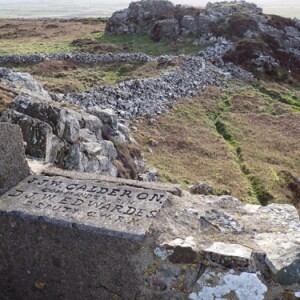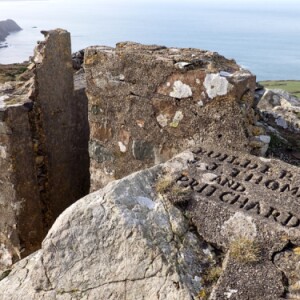Temps perdu etc.
A cloudless day called for a long coastal walk starting from Garn Fawr, a neolithic hill fort that dominates the land's edge south of Fishguard. It had strategic importance prehistorically judging by the still-substantial loose stone fortifications, but also in both world wars as a lookout point for monitoring enemy activity in the Irish Sea.
In this view the concrete structure on the left is what remains of the WW1 observation point while to the right can be seen a compass engraved on the rock surface and dated 1915.
The story continues in the other images....
1st extra. Looking west, what may have been ancient stone ramparts can be seen linking the high points and in the foreground the names of the officers responsible for manning the look-out: JJW CALDERON (Commander RN) and DJW EDWARDES (Deputy). In the past I have researched both. Calderon had served with the Royal Indian Navy and there's a slight suspicion he may have been invalided out for mental health reasons. However he looks on good form when visiting the Cutty Sark in 1938 here.
Edwardes (the spelling is that of a well established West Wales gentry family) would have been happier beside a river than on a windswept crag if this is anything to go by - he's described as a famous angler.
Much less can be found about the builders of the lookout point (2nd extra) Messrs. Thomas and Pritchard, but I intend to have a try using my local history hat.
The 3rd extra illustrates a much earlier event that actually created what we know as Garn Fawr: volcanic activity millions of years ago was responsible for our rugged coastline with its profusion of craggy headlands and deep bays. The symmetrical stone pillars that resemble the ridges of folded paper are known as columnar jointing, and were formed by the rapid cooling of volcanic material - liquid stone without enough room to expand.
4th extra, recent history: the bench on the high point of Penbwchdy a mile ot two south looks back towards Garn Fawr across Pwll Deri bay. It's dedicated to Bill Williams. In I980 when we made our very first visit to Pembrokeshire we arrived at midnight on the boat train. Bill Williams was at the station to meet us. The friends who accompanied us had booked into a B&B he and his wife ran in a nearby village. Bill and Dulcie were wonderful hosts and her cooking was divine. Bill died in 1982 and Dulcie (who was around when we moved here 10 years later) had this seat placed here in his memory. I was surprised to find it still intact: it's had a some repairs.
Finally (no. 5) - the future??? Further along our route a huge section of the cliff has recently collapsed. There's nothing new about coastal erosion but as we all know it's not going stop any time soon.




Comments
Sign in or get an account to comment.


